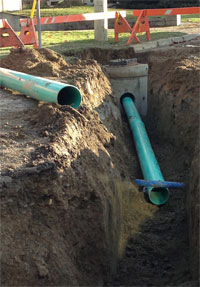The Town of Creston, British Columbia faces challenges in sustaining aging infrastructure and managing growth.

By Colin Farynowski, Manager of Engineering, Town of Creston and Sid Smith, Asset Management Specialist, Associated Engineering
With a population of over 5,000 residents, the Town is now required to pay 70% of policing costs. For a small municipality like Creston, this translates to about a 25% immediate increase in taxes. An Asset Management Plan was critical to the Town’s budget.
The plan included seven crucial steps, which other small municipalities might consider when implementing their own asset management strategy.
Step 1 – The Foundation
The first step was establishing an asset register and valuation in order to satisfy the requirements of Public Sector Accounting Board (PSAB) reporting. Since January 2009, all municipalities are required to account for their tangible capital assets (TCA) and amortize them in their financial statements.
The asset register template adopted by the Town of Creston was originally developed for PSAB inventory data collection and condition assessment information for a number of communities in northern Saskatchewan.
This tested data model helped define the data required to collect and automate calculations for annual and accumulated amortization, disposals and net book value to produce PSAB TCA reporting.
Step 2 – Data Collection
With the asset register in place, a thorough, methodical approach was applied to completing an inventory, which included all municipal assets such as water, sewer, signs, street lights, equipment and buildings. All historical information was reviewed and compiled before collecting any field data.
The search included all available construction records for community infrastructure. A 2009 Road Infrastructure Study provided verification of all road assets, including length, surface and current conditions. Creston’s current road network contains approximately 45 kilometres.
In addition to PSAB reporting, location data was also used to create mapping of all the Town’s infrastructure assets in a manifold GIS [Geographic Information System] linked directly to the asset register.
A data gap analysis outlined missing information, including age of assets, material and life expectancy. This holds the key to establishing PSAB valuation and reporting such as quantities, materials, in-service dates and historical costs.
Step 3 – Valuation
Another gap became apparent when determining historical costs as much of the information was not available for older assets. This led to a search through insurance values and recent contract tenders for communities in the area. These values were also used for recently constructed assets where actual invoice or tender pricing was available.
The valuation threshold was set at $5,000. Critical assets or components below this threshold value were aggregated to an amount above the threshold. Every asset has also been assigned a unique ID for tracking purposes to ensure each asset is only accounted for once.
Useful lifecycle estimates of each infrastructure asset were taken directly from the Guide to the Amortization of Tangible Capital Assets, published in May 2008 by the BC Ministry of Community, Infrastructure and Finance Division.
Step 4 – Quality Checking
The data gap analysis produced at Step 2 was a trigger for collecting data directly from the assets. This step also helped to confirm and correct data where necessary. All of the inventory information was reviewed and verified to confirm the location and type of infrastructure.
Step 5 – Establishing Internal Processes
TCA reports are produced by the Finance Department for inclusion in the Town’s financial statements. The audited asset inventory must be maintained on an ongoing basis in collaboration between the Finance and Engineering departments, by tracking additions, betterments and disposals. The goal is to keep this information current not only for reporting requirements, but also to assist staff and Council with decision making and strategic planning.
Step 6 – Condition Assessments
The Town will continue to add and refine asset condition ratings on a day-to-day basis as well as scheduled annual inspections. Over a period of time, the frequency and method of data to be collected will be refined to account for the service being provided by each particular asset.
Conducting and maintaining condition assessments will ensure the data is used to determine the need and timing of some preventative or remedial action to maintain the desired level of service.
Generally core condition ratings from 1 (very good) to 5 (unserviceable) are implemented. As a sub-set to condition assessments, each asset class has its own risk profile which needs to be considered to meet the Town’s corporate and strategic objectives.
Step 7 – Ownership
In addition to meeting the requirements of PSAB reporting, Creston has acquired a GIS and Spatial Data Management System. This tool enabled the Town to map important operations information such as snow-clearing routes and waste collection areas.
The building blocks are in place for making informed, evidence-based decisions on where to target spending for capital and maintenance investment.
With these systems in place, the Town of Creston is proactively able to manage tangible assets throughout their lifecycle in order to face the challenges of aging infrastructure.